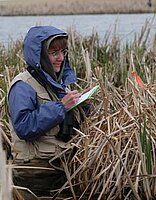Effects of West Nile Virus Infection, Immune Function, and Age on Female Yellow-headed Blackbird (Xanthocephalus xanthocephalus) Reproduction.

Jennifer L. Newbrey (PhD Candidate)
Department of Biological Sciences
Email: Jennifer.Newbrey@ndsu.edu
Degrees:
2002 - M.S. Univ. of Wisconsin – Stevens Point, Natural Resources: Wildlife
1997 - B.S. Univ. of Wisconsin – Stevens Point, Wildlife and Biology
Fellow: Jennifer L. Newbrey, Department of Biological Sciences, NDSU
Advisor: Wendy L. Reed, Assistant Professor of Zoology, NDSU
Matching Support: NDSU
Degree Progress: Ph.D. expected in December 2006.
Effects of West Nile Virus Infection, Immune Function, and Age on Female Yellow-headed Blackbird (Xanthocephalus xanthocephalus) Reproduction.
Recent high water levels and canalization of water resources (i.e., Garrison Diversion) in North Dakota have resulted in an increase of aquatic habitats for many wildlife species. Current water conditions correspond with increased numbers of wetland breeding birds and increased habitat for breeding mosquitoes. Because birds often serve as intermediate hosts for mosquito borne diseases, increased populations of birds and mosquitoes could impact the ecology, rate of emergence, and persistence of diseases in humans and wildlife. The recent spread of WNV into the state has produced a need for research to study the prevalence of the virus in North Dakota’s wetland wildlife.
The North Dakota Department of Health reported the first cases of WNV in the state in the summer of 2002. The first bird to test positive for WNV was an American crow (Corvus brachyrhynchos) found on July 14th, and the first positive human cases were reported on August 28th. There were 19 human cases of WNV and 2 deaths in the North Dakota in 2002. In 2003, the virus was much more widespread, with 422 human cases and 189 positive bird carcasses (out of 788 tested). During the summer and fall of 2004, the virus was much less prevalent in the state with only 20 human cases and 67 positive bird carcasses (out of 456 tested). The North Dakota State Department of Health also tested live birds for the first time in 2004 and found 36 out of 617 to be positive for WNV antibodies (North Dakota Department of Health unpub. data)
Because stagnant water in wetlands is ideal breeding habitat for mosquitoes, wildlife associated with these habitats may suffer high rates of WNV infection. The recent arrival of WNV into the state necessitates a study of the prevalence of WNV in native North Dakota wetland species. Most research on the virus has focused on using carcasses of birds as a surveillance system for detecting the spread of WNV across North America. No published research has been conducted on a living population of free-ranging birds. Failure of biologists to adequately address disease emergence in free-ranging wildlife may lead to diminished geographic distributions and populations declines.
The prairie coteau region of central North Dakota has many small prairie wetlands, which provide essential foraging and breeding habitat for many species of birds. Yellow-headed blackbirds are an ideal species to study WNV infection because they breed in high-density wetland colonies throughout the coteau. Establishing rates of WNV infection in yellow-headed blackbirds is necessary to determine the vulnerability of this wetland dwelling species to WNV infection. Information gathered on WNV for this study can also be used to model and predict potential impacts of the virus on other species of wetland birds.
Objectives and Methods:
The objectives of my dissertation research are to 1) quantify the prevalence of exposure to WNV in a free-living population of yellow-headed blackbirds, 2) quantify variation in immune function of female blackbirds, and 3) measure the relationship between female immune function and carotenoid allocation to eggs. These objectives will allow me to evaluate potential relations between wetland bird WNV infection and increased aquatic habitat for breeding mosquitoes in North Dakota.
Female yellow-headed blackbirds were captured using nest traps to collect blood for WNV antibody detection and immunity quantification. Blood serum was tested for WNV antibodies using competitive enzyme-linked immunoabsorbent assay (ELISA) specifically designed to detect WNV antibodies in blood serum from avian species. To assess variation in immune function among females, I created blood smears and obtain ratios of immune system cells (heterophils to lymphocytes). Prior to release, each female was banded with a standard Fish and Wildlife Service aluminum band along with a unique color-band combination for individual field identification. I located and monitor nests of each banded female yellow-headed blackbird to determine nest success and nestling performance and how differences in carotenoid levels influences reproduction. Male yellow-headed blackbirds and other members of the Family Icteridae (red-winged blackbirds, common grackles, etc.) were also captured using live funnel traps for WNV antibody detection.
This study was conducted on several wetlands located within a five square mile area of the prairie coteau region of central North Dakota (Stutsman County). Central North Dakota has one of the highest concentrations of breeding yellow-headed blackbirds in North America. In addition, Stutsman County has one of the highest numbers of positive avian West Nile virus cases in central North Dakota (CDC unpub. data).

Project Progress:
2003
Field Season:
I collected third-laid eggs from 51 female yellow-headed blackbirds on 7 different wetlands. I captured 20 female yellow-headed blackbirds and collected blood and feather samples for WNV antibody detection and carotenoid analysis. I also collected blood samples from 9 male yellow-headed blackbirds, 19 grackles, 2 red-winged blackbirds, and 1 western meadowlark to use for WNV detection. I tested the blood samples for WNV antibodies and I detected antibodies in two individuals, one red-winged blackbird and one western meadowlark.
Oral Presentations:
Jennifer L. Newbrey, 2003. Presentation to the NDWRRI Advisory Committee
Newbrey, J.L. and W.L. Reed. 2003. Detecting West Nile Virus Antibodies in Central North Dakota Yellow-headed Blackbirds. 59th Annual Meeting of the Entomological Society of Manitoba.
2004
Field Season:
I collected blood samples from 91 yellow-headed blackbirds, 24 common grackles, three house sparrows, two brown-headed cowbirds, and one red-winged blackbird. I tested all of the serum samples for WNV antibodies and I found five positive for WNV antibodies, two female yellow-headed blackbirds, two house sparrows, and one common grackle. I also collected 25,000 mosquitoes and identified a subset of the mosquitoes to the species level. Culex tarsalis, a species known to transmit the virus in North Dakota, were present in all of my collections, but at low levels (5%). Jeffery Bell at the University of North Dakota helped to test the mosquitoes for WNV RNA using polymerase chain reaction, but all samples were negative for the virus.
Oral Presentations:
Newbrey, J.L., and W.L. Reed. 2004. West Nile virus antibodies in central North Dakota icterids. Cooper Ornithological Society 74th Annual Meeting.
Poster Presentations:
Newbrey, J.L. 2004. West Nile virus antibodies in central North Dakota icterids: Implications for ecology and management. North Dakota Chapter of the Wildlife Society Annual Meeting.
Newbrey, M.G. and J.L. Newbrey. 2004. Evidence for long-term abundance fluctuations of piscivorous birds in North Dakota from a fossil record of fish populations responding to climate change. North Dakota Chapter of the Wildlife Society Annual Meeting.
Manuscripts Submitted:
Newbrey, J.L. and W.L. Reed. West Nile virus antibodies in free-living central North Dakota icterids. The Condor.
2005
Field Season:
I collected eggs, feathers, and blood samples from 69 female yellow-headed blackbirds. I also monitored nest success of all study nests and measured daily growth rates of 133 chicks from 55 nests. In the lab, I obtained white blood cell ratios for each female to quantify differences in female immune function. I am currently setting up my HPLC protocol for quantifying levels of carotenoids in egg yolks of yellow-headed blackbirds
Oral Presentations:
Newbrey, J.L., and W.L. Reed. 2005. Effects of nest contents and minimum daily temperature on female Yellow-headed Blackbird nest attentiveness. Wilson Ornithological Society and Association of Field Ornithologists Joint Meeting.
Manuscripts Submitted:
Newbrey, J.L and W.L. Reed. Effects of nest contents and minimum daily temperature on female Yellow-headed Blackbird nest attentiveness. Submitted to The Journal of Field Ornithology.
Grants:
Newbrey, J.L. 2005. Effects of Nest Contents and Minimum Daily Temperature on Female Yellow-headed Blackbird Nest Attentiveness. Wilson’s Ornithological Society Student Travel Award. $200.
Newbrey, J.L. 2005. Effect of Female Immune Function on Carotenoid Tradeoffs in Free-living Yellow-headed Blackbirds (Xanthocephalus xanthocephalus). American Ornithologists’ Union, Bleitz Research Award. $1,400.
Significance of Research:
This study will provide essential information on the prevalence of WNV in a North American avian species. Infection with the virus can be lethal; however, the degree to which birds are adversely affected varies among species and even between individuals within a species. By testing for the presence of antibodies to WNV in yellow-headed blackbirds, I will be able to assess the vulnerability and degree of virus exposure in a free-living population of wetland dwelling birds. Many wildlife pathogens cause non-lethal physiological and reproductive effects that remain poorly understood. Because female birds allocate essential resources to eggs, exposure to pathogens can shift maternal resources away from reproduction. This seemingly small, non-lethal effect influences the survival of offspring and can therefore cause population level effects in the next generation.

Wendy Reed
Biological Sciences


